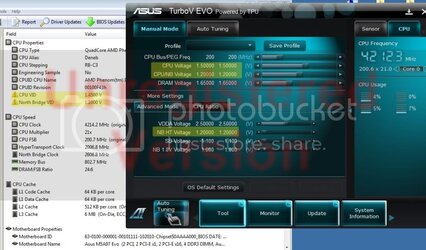Hi,
I realize this thread is roughly 2+ years old.
Can someone help me with K10Stat?
Preliminary experimenting has indicated K10Stat has solved a problem I was having, but I am not 100% sure I have a "good" K10Stat configuration...and I am still wondering how K10Stat affects BIOS settings ie. Does K10Stat Override a Bios Cpu FID?
YES, K10Stat does override those settings at login time (not before). This means that if you set your BIOS settings too low (undervolted) or too high (overheating) to boot then you have locked yourself out!
Always be conservative with changes, a bit at a time.
Why have any change in P-State at all? Except for Resets/Boots/Crashes/Power up/downs, why would I want a lower P-State?
Changes in P-States are desirable when you want to save power or overboost your system accordingly and dynamically with workload variations on the processor. I use mine to save energy and cool down the processor when it is not used much and also boost/overclock it when my load goes above high levels so that it is not overclocked all the time.
Sorry if this is ignorant question...Aren't these P-States mainly to save Power? In other words, if I don't care about how much juice my PC is consuming all the time, and I just want 1 constant frequency/power state (unless BIOS needs something specific for errors or w/e), is this possible, or maybe negative consequences?
YES, using K10Stat to make all P-States the same value is useless, you would be better off setting the Cool'n'Quiet OFF altogether and setting the desired FID in the BIOS; that will remain throughout.
I guess if someone replies, I'll post some questions

. It's an extremely useful Utility, but I might inadvertently screw things up as I am want to do...
P.S. I suppose I should at least explain the original problem a bit. Battlefield 3 was crashing/hanging/stuttering all the time. Very frustrating. I read about different solutions, etc. but PC still failed with BF3. Tried lots of Bios settings, tweaks, etc. Nothing was working, so I went back to stock/defaults on everything.

Was able to rule out various possible problems though trial and error. Started monitoring everything I could via AIDA64...I noticed that even when I boosted NB vid in Bios, the voltage reported stock settings...I am using a NB = 2600MHz and I knew I needed more than stock voltage (around 1.175-1.2v). So to cut to the point, I "think" what may have been happening is that during BF3 gameplay the P-State lowered and triggered a lower NB vid, basically mucking up Northbridge in a situation where NB performance was needed, hence an "AppHang" or more commonly a "frozen" BF3 reporting it is still running in TaskManager, but no Video...something along those lines...
So my layman's approach after reading a bit was to "widen" the gap between P0 & P1 so that any State that BF3 drops in to or rises up to, is within that P0 to P1 range...basically I was trying to Force my PC to think it needed Full Power whenever running BF3...Will this work?
Thanks.



 :
:
